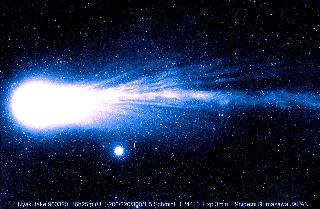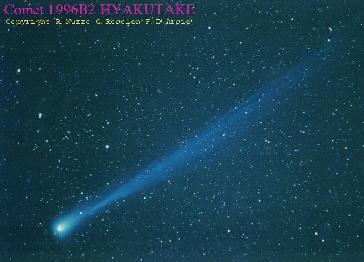| |
 |
| |
Image
of Comet Hyakutake taken by Shigemi Numazawa
from Nigata, Japan on March 20, 1996.
|
On January 30, 1996, Yuji Hyakutake in Japan
discovered a new comet using his massive 25x150
binoculars. The comet reached a peak brightness
of about 0 magnitude, the brightest since Comet
West in 1976 (Comet Hale-Bopp would reach magnitude
-1 the following year). The comet made a particularly
close flyby of the Earth on March 25, 1996 at
a distance of 0.10 AU, and reached its perihelion
(closest distance to the Sun) on May 1, 1996 at
a distance of 0.23 AU.
 |
|
Image
of Comet Hyakutake taken from Col Druscie
Observatory in Italy on March 25, 1996.
|
|
Radar observations of the comet by Steve Ostro
from JPL on March 24-25, 1996 showed the comet
nucleus to be only from 1 to 3 km. Though the
comet nucleus was small, its brightness was due
to its close passage by the Earth. Another side
effect of the close flyby was that viewers from
Earth were able to view the comet broadside, and
the comet exhibited a tail up to 100 degrees long!
This is one of the longest comet tails ever observed
in history.
| Last updated
November 26, 2003 |
|
